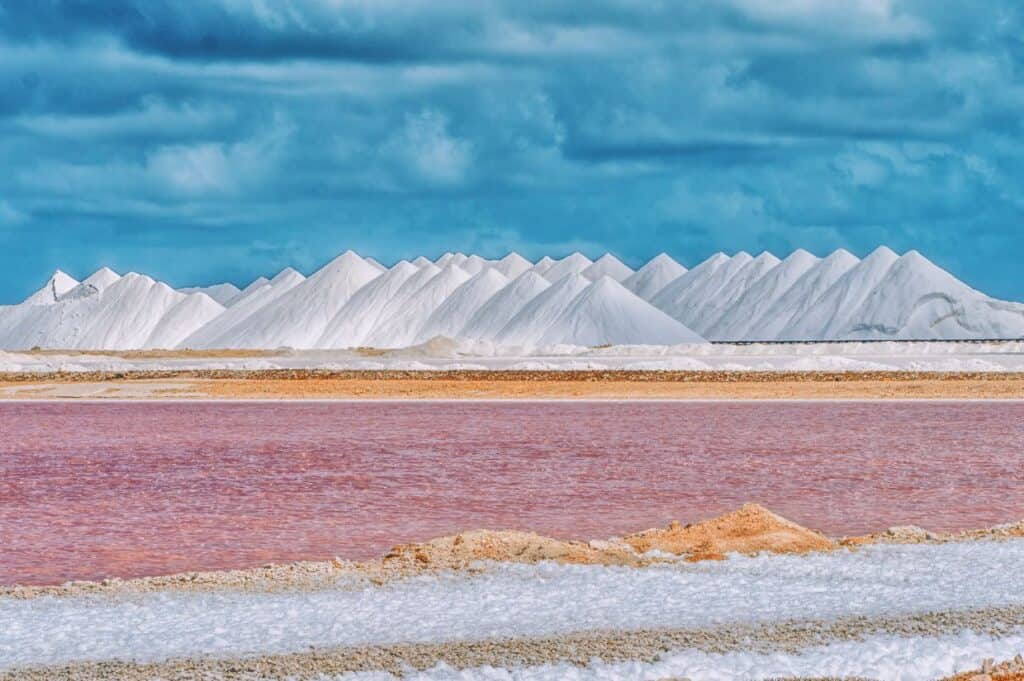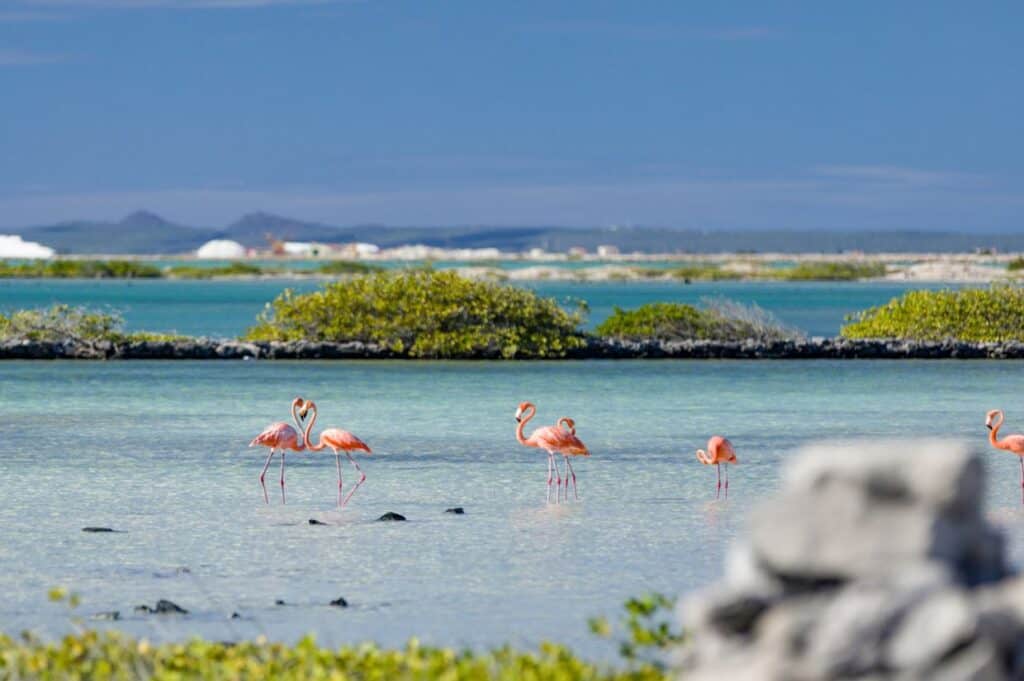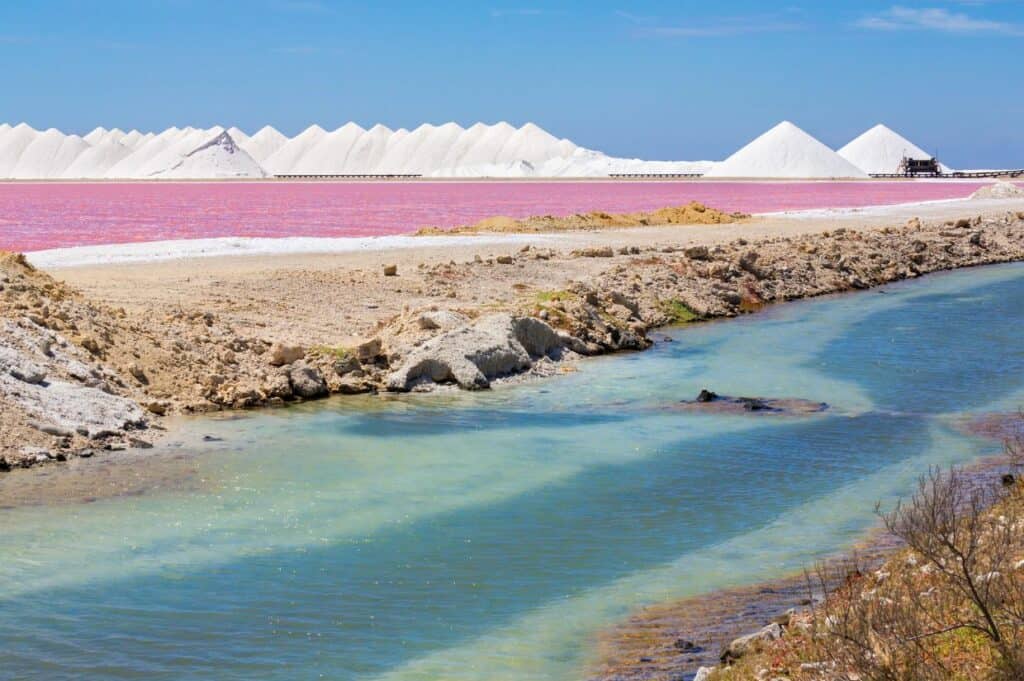Bonaire, the quiet gem of the Dutch Caribbean, is known for its incredible underwater world, but there’s a part of the island that stands out, quite literally, on the surface — the salt flats. If you’ve ever been captivated by the sight of shimmering pink waters and towering white salt mounds, then you’re already halfway to understanding what makes this place special. And if you’re into ecotourism, Bonaire’s salt flats should definitely be on your radar. Here’s why this unique spot is worth your time (and Instagram feed).

The history behind Bonaire’s salt
Before we get into the ecotourism aspect, a little history helps set the scene. Bonaire’s relationship with salt goes way back, centuries in fact, to the early 1600s when the Dutch colonized the island. Salt was big business back then. The sun, strong winds and shallow pools created the perfect environment for salt production, which was shipped back to Europe for preservation.
Over time, Bonaire’s salt industry grew and became one of the island’s main exports. Today, the process remains, but the focus has shifted more toward sustainability and conservation, aligning with Bonaire’s commitment to eco-friendly tourism.
The Salt Pyramids: Not just for show
When you arrive at Bonaire’s southern tip, the first thing you’ll likely notice is the surreal landscape. Massive salt pyramids stand tall against the blue sky, while pink-hued salt flats stretch out in every direction. It almost feels otherworldly — like you’ve stepped onto another planet.
These pyramids aren’t just for decoration, though. They’re the result of months of evaporation, where seawater is drawn into shallow pans and left to bake in the Caribbean sun. The water evaporates, leaving behind salt crystals, which are then raked into massive piles. While it might look like something out of a sci-fi movie, this process is entirely natural and environmentally friendly. It’s low energy, relying mostly on solar power, and it’s been a sustainable practice for generations.
Pink waters, flamingos and ecotourism
You might be wondering — why is the water pink? The answer is pretty cool: Microorganisms called halophiles thrive in high-salinity environments, giving the water its rosy tint. And they’re not the only ones who love the salt flats. Bonaire’s salt pans are also home to one of the island’s most popular residents — flamingos.

The salt flats of Bonaire double as important feeding grounds for flamingos. These long-legged beauties flock to the area in search of their favorite snack: Brine shrimp, which thrive in the salty waters. Seeing a flamingo in the wild is always a treat, but there’s something extra special about spotting them in the salt flats, surrounded by the striking pink hues.
For ecotourists, this is where things get exciting. Bonaire is a leader in sustainable tourism, and the salt flats are a key part of the island’s conservation efforts. By visiting, you’re not only experiencing an incredible natural wonder but also supporting local efforts to protect the delicate ecosystems of the island.
How to explore Bonaire’s salt flats responsibly
You’ve decided to visit the salt flats — great choice! But it’s important to do so responsibly. Bonaire’s ecotourism model is all about minimizing impact while maximizing experience, and there are a few ways you can ensure your visit aligns with that ethos.
First, stick to designated viewing areas and trails. The salt flats might look like an open playground, but they’re home to sensitive wildlife, particularly the flamingos. Walking through unauthorized areas could disturb nesting sites or feeding grounds, so it’s crucial to respect the boundaries.
Another pro tip? Bring binoculars! While you can definitely see the flamingos from afar, getting a closer look without disturbing them is best done with a good pair of binoculars or a zoom lens. Plus, you’ll get an up-close view of their striking pink feathers against the pink water — an unforgettable sight.
And of course, don’t leave any trash behind. Bonaire prides itself on being one of the cleanest islands in the Caribbean, and keeping it that way requires a little effort from everyone.
Salt as a renewable resource
It’s easy to take salt for granted, but on Bonaire, it’s a renewable resource that’s been sustainably harvested for centuries. The island’s salt flats offer a lesson in how humans and nature can coexist harmoniously. The salt is harvested without harming the environment, and the process relies on natural elements like the sun and wind to do most of the work.

For those interested in the nitty-gritty details, Bonaire’s salt production is a perfect example of circular economy principles. The salt pans are filled with seawater, which evaporates naturally. The remaining salt is harvested, and the process starts all over again. There’s minimal waste, and the energy used is almost entirely renewable. It’s a win-win for both the environment and the local economy.
Supporting local conservation efforts
One of the best things about ecotourism is that it often goes hand in hand with supporting local conservation efforts, and Bonaire is no exception. By visiting the salt flats, you’re contributing to the island’s sustainable tourism initiatives. Many local tour operators offer guided visits to the flats, with a portion of the proceeds going toward conservation programs. It’s a small way to give back while enjoying the island’s natural beauty.
If you’re really passionate about conservation, consider donating to STINAPA, the organization responsible for managing Bonaire’s protected areas, including the salt flats. Their work ensures that the island’s ecosystems remain healthy and thriving for generations to come.
Beyond the Flats: What else to see and do
While the salt flats are definitely a highlight, there’s so much more to Bonaire’s ecotourism scene. After you’ve soaked in the surreal beauty of the flats, consider heading out for some of the island’s famous snorkeling or diving destinations. Bonaire’s waters are teeming with vibrant coral reefs and marine life, and the island is a designated marine park, so you can rest assured that your visit is supporting conservation efforts both on land and at sea.
If you’re more into hiking, the island’s Washington Slagbaai National Park offers miles of trails through rugged landscapes and stunning viewpoints. It’s the perfect way to experience Bonaire’s natural beauty beyond the salt flats.
Why the salt flats matter
At first glance, Bonaire’s salt flats might just look like a cool place to snap a few photos. But when you dig a little deeper, you’ll realize they’re a testament to the island’s commitment to sustainability and conservation. From the low-impact salt harvesting process to the thriving ecosystems that call the flats home, this unique landscape is a shining example of how ecotourism can make a positive impact.
So next time you’re on Bonaire, don’t just head for the beaches and dive spots — take a trip to the salt flats and see how the island is working to protect its natural resources, one grain of salt at a time.